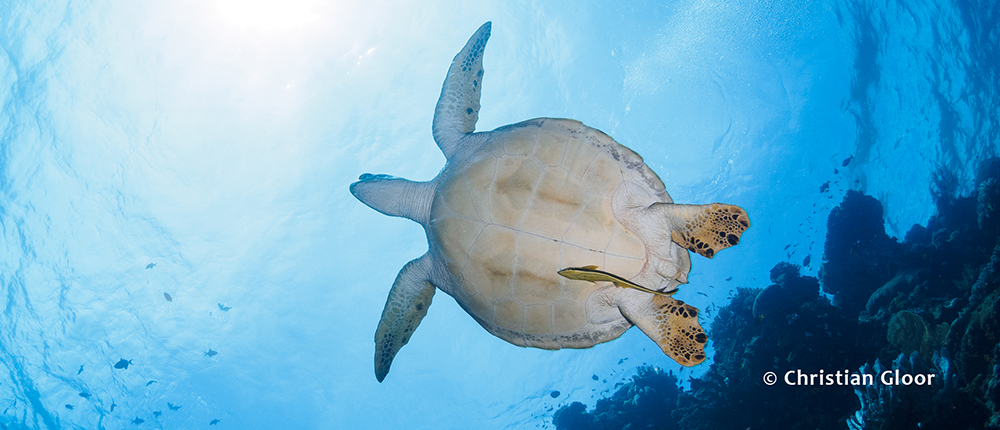Wakatobi’s Turkey Beach is Not for the Birds
If Wakatobi’s dive site Turkey Beach is not about turkeys, then what’s it all about?
Look at a map of Wakatobi’s Reefs and you’ll notice that the dive site known as Turkey Beach is listed as #1. That makes sense, because — save for the House Reef — it’s one of the two closest named sites to the resort’s jetty. How close is it? If you were sitting with your morning coffee at Wakatobi’s oceanfront restaurant gazing out over the water, you would be looking right at the start of it.
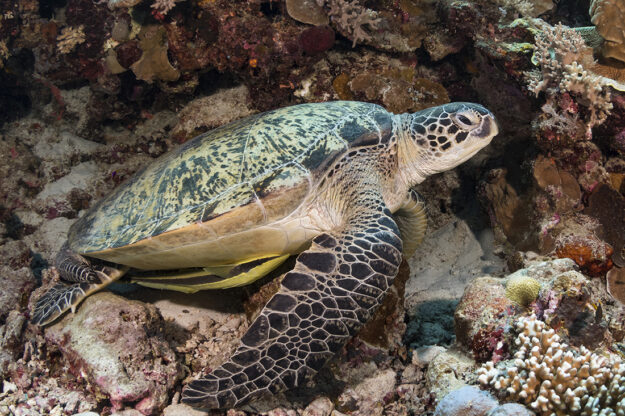
Day or night, divers will encounter a healthy population of both juvenile and adult turtles at Turkey Beach. Photo by Wakatobi Resort
But what about the turkeys? Turns out the name of this site has nothing to do with birds and everything to do with languages. Do you know the story?
Turkey Beach is known as one of the best sites in the Wakatobi marine preserve to find green and hawksbill turtles. Day or night, divers will encounter a healthy population of both juvenile and adult turtles. At high tide, they come into the shallows to nibble on seagrasses. They nap under ledges and patrol the reef tops. Move a little deeper and you may also encounter a few hawksbill turtles noshing on sponges.
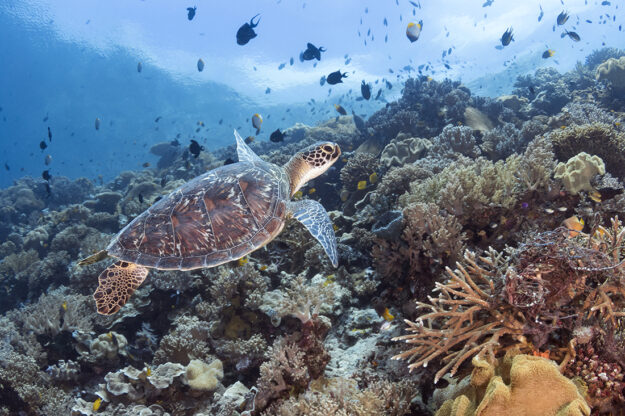
At Turkey Beach, green and hawksbill turtles can be found nibbling on seagrass, napping under ledges, and patrolling the reef tops. Photo by Walt Stearns
Given the number of turtles found at this site, you might wonder why it wasn’t named Turtle Beach. The answer has to do with the multi-lingual nature of Wakatobi’s clientele. Back in the early days of the resort, a guest from Germany was enthralled by the many sea turtles encountered during a dive but also had some challenges grasping how to say “turtle” in English, and mistakenly referred to them as “turkeys.” From that point on, the name Turkey Beach stuck.

Turkey Beach is a continuation of the same reef system that makes up the House Reef, complete with coral-covered reef slopes and vertical walls. Photo by Wakatobi Resort
From a diving and snorkeling perspective, Turkey Beach is actually a continuation of the same reef system that makes up the House Reef. The inshore region, which is far larger than the House Reef is dominated by a broad expanse of seagrass beds 1 to 3 meters deep. Outward, the plateau changes composition to a rich and lively coral reef that makes a similar abrupt drop off into the depths, but with a few subtle differences in its topography.
Rather than having a near-vertical profile running continuously, the reef face periodically changes tempo from wall to steep slope and back again. As you move along its face you’ll find a wonderland of hard and soft corals, and sponges, from the top of the reef (at a depth of 2 to 3 meters) down past the 50-meter mark.
When currents hit their zenith, schools of fish gather to feed near the reef’s crest. In between colorful anthias and fusiliers dart about in their attempts to catch a meal without becoming one themselves. At any given time, you may encounter a passing eagle ray or two or a roaming school of spadefish or hump head parrotfish. A closer look into the folds and crevices of the reef will reveal a wide range of crustaceans and other invertebrates.
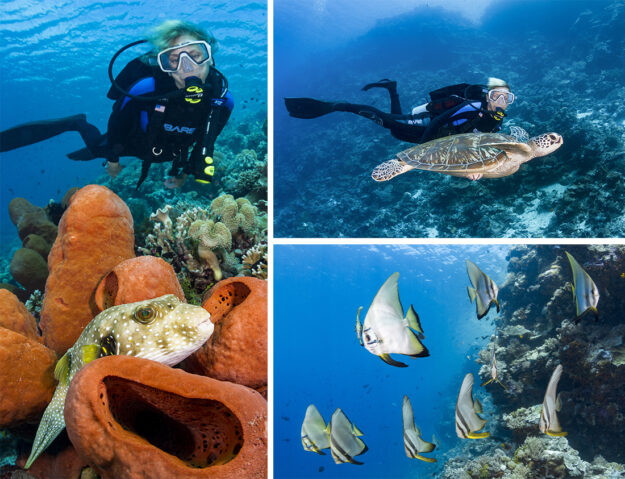
Some of the sights you will see at Turkey Beach include large white-spotted pufferfish (Arothron hispidus), golden spadefish (Platax boersii) and of course green sea turtles (Chelonia mydas). Photo by Walt Stearns
Much like the House Reef, currents at Turkey Beach can fluctuate in strength and direction, flowing both north and south based on the tide cycle. As a result, there is no mooring buoy at this site, and all dives are conducted as drifts. Depending on the strength of the current, dive plans could involve a gentle drift or become a brisk ride.
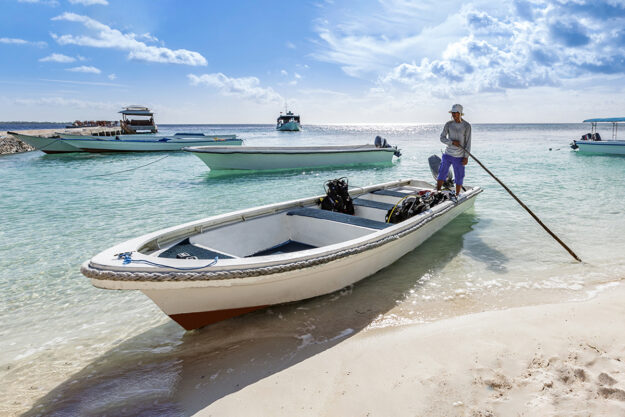
A taxi boat drop can drop divers and snorkelers at Turkey Beach for an extended drift back to the Jetty. Photo by Wakatobi Resort
In addition to regularly scheduled visits by the resort’s dive boats, Turkey Beach is served by the Wakatobi taxi boats. When currents are flowing to the north, divers and snorkelers can take a short taxi boat ride to the site, then enjoy an extended drift dive that brings them back to the resort jetty.
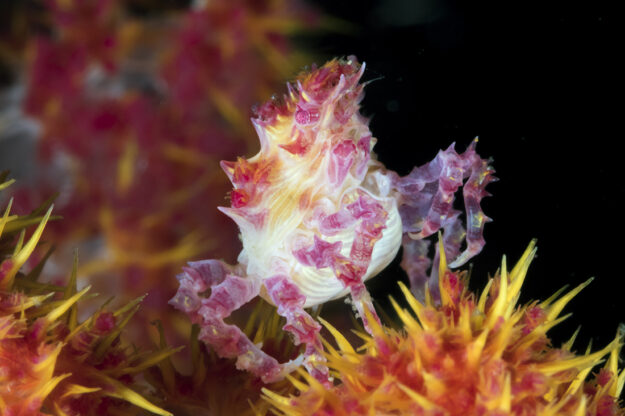
Night time is the right time to find Coral Crabs (Hoplophrys oatesii) at Turkey Beach. Photo by Wakatobi Resort
Between its close proximity to the resort and what it has to offer, Turkey Beach is also one of Wakatobi’s popular night diving sites. After dark, you’ll likely find the turtles tucked up under a ledge sleeping. You’ll also find the usual cast of nocturnal creatures, including lionfish on the hunt, octopus slithering among the corals, squids on patrol, parrotfish tucked into their mucous cocoons, and all manner of crabs scurrying about.
Day or night, a dive at Turkey Beach is a rewarding experience, and it remains one of Wakatobi’s most-loved dive sites.
Join us for a dive at Turkey Beach! Contact our team to plan your dream dive vacation: office@wakatobi.com or Enquire >here.


